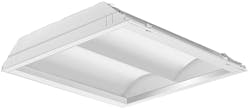Acuity Brands details its location-services platform for solid-state lighting
At LightFair International (LFI), Acuity Brands announced a partnership with Qualcomm Technology focused on offering indoor location services for applications such as retail using Visual Light Communications (VLC) between an LED light fixture and the camera on a smartphone or tablet. Moreover, Acuity demonstrated the technology using a commercially-available solid-state lighting (SSL) product comprised of an Acuity-developed LED light engine and a microcontroller (MCU)-based driver from the company's EldoLED brand. Subsequent to LFI, Steve Lydecker, senior vice president of applied integrated solutions at Acuity, provided more details on the location technology and said an actual deployment with a retail customer should happen in this calendar year.
As we discussed with the recent article about the location-services demonstration by GE Lighting at LFI, the allure of the technology for retailers is the opportunity to interact with the customer and increase sales. The technology would allow retailers to offer targeted sales based on the area in which a customer is shopping, or guide the customer to specific merchandise.
The Acuity offering, however, could be closer to market-ready than the GE implementation based on technology from startup ByteLight or the Philips technology demonstrated for the first time back in February. According to Lydecker, Acuity will add no hardware to existing LED fixtures to support the Qualcomm Lumicast platform.
Qualcomm has yet to formally announce Lumicast beyond the Acuity-issued press release, but the company asserts that Lumicast, enabled by software on the mobile device and in the cloud, can determine the location of a mobile device to within 10 cm in three dimensions. The technology can also detect the orientation of the device so a retailer could discern on which side of the shopping aisle the customer is focused.
To support Lumicast, Acuity simply has to modulate the light from an LED fixture in a manner that is compatible with the Lumicast platform. Lydecker said in the case of the Breez LED fixture from Acuity's Lithonia brand, which was demonstrated at LFI, the EldoLED ECOdrive used in the fixture has the capability of implementing the modulation. The MCU-based driver would require a firmware or software addition to support Lumicast but no additional hardware. Acuity could offer Lumicast support as an option, just as it optionally offers other features such as 0–10V dimming or support for DALI (digital addressable lighting interface).
Indeed, a network connection is another potential requirement for any indoor-positioning service since a retailer needs to commission a fixture and perhaps update the data that it transmits over time. And Lydecker said Acuity would support both Acuity-proprietary and industry-standard wired and wireless networks with the ECOdrive family.
At LFI, GE and ByteLight stressed the fact that their system uses both VLC and Bluetooth Low Energy (BLE) RF communications to enable fixture-to-mobile-device communications. BLE would come into play when there is no line-of-sight link between the fixture and device.
Acuity's demo was strictly based on VLC. Lydecker said that the primary benefit of BLE would be the ability to connect to a smartphone that is in a customer's pocket or purse. Of course, since any such location implementation requires the customer to opt in to the services and download an app, the customer would presumably have the device out and available when shopping. Lydecker said Acuity will add BLE support if retailers ask for it, although he also added, "The light fixture may not be the best place for a Bluetooth beacon."
Lydecker said Acuity is already involved in a trial of the technology in a large mock store with what he termed a "significant retailer." And that trial is based on VLC alone.
Qualcomm has also announced a BLE-based location platform called Gimbal for mobile devices. The company demonstrated it at the South by Southwest (SXSW) music and technology festival held in Austin, TX earlier this year. One would speculate that the Gimbal and Lumicast technologies could be used together if needed. But Lydecker said the VLC implementation delivers much better resolution than BLE or Wi-Fi-based RF systems that have been announced by other companies.
As for what else it would take for the Acuity technology to be deployed this year, the retailer in any such deployment would most likely take the lead in developing the customer engagement side of the technology platform. Lydecker said, "Retailers want to control the customer interface." But the combination of the Acuity lighting product and the underlying Lumicast platform are essentially ready now for such development.

Maury Wright | Editor in Chief
Maury Wright is an electronics engineer turned technology journalist, who has focused specifically on the LED & Lighting industry for the past decade. Wright first wrote for LEDs Magazine as a contractor in 2010, and took over as Editor-in-Chief in 2012. He has broad experience in technology areas ranging from microprocessors to digital media to wireless networks that he gained over 30 years in the trade press. Wright has experience running global editorial operations, such as during his tenure as worldwide editorial director of EDN Magazine, and has been instrumental in launching publication websites going back to the earliest days of the Internet. Wright has won numerous industry awards, including multiple ASBPE national awards for B2B journalism excellence, and has received finalist recognition for LEDs Magazine in the FOLIO Eddie Awards. He received a BS in electrical engineering from Auburn University.





